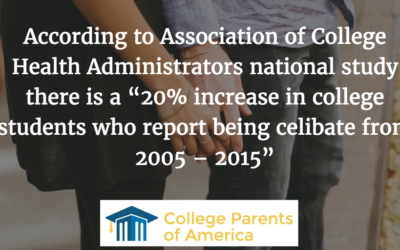
Valentines Day is here again. So there may not be a better time than to discuss sex in college.
College sex is a real issue but how do we know what is actually happening? College Parents of America went out to find the truth beyond the headlines.
The recent book American Hookup: The New Culture of Sex on Campus by the sociologist Lisa Wade has brought attention to the subject of sex in college. Her work is comprehensive and helpful to college students and families alike. Her work contains a useful overview that defines the modern hookup culture is and also what it is not. Wade’s book dispels many myths about it, including the one that everyone on a college campus is having loads of sex, all the time, with multiple partners.
To Wade’s credit, she tells a comprehensive story with real data. Despite the portrayal of college students being naïve and careless, American College Health Association (ACHA) statistics prove the contrary. The ACHA’s National College Health Assessment provides a longitudinal view of data that provides insights into the reality of college sex and its impact on college student health.
College Sex & Hookup Culture: Despite the growth in social media and “hook-up” applications like Tinder a careful review of data from 2005 – 2015, indicates that college students report a decreased number of sexual partners. In fact, the reported celibacy rate of students increased: with male celibacy increasing two times the rate of females.
In fact, the 2015 data reports that 33.5% of college students report having no sexual partners which are up from 27.5% reported in 2005.
And for students that report being sexually active, a remarkably consistent number of students report being monogamous or having one sexual partner in the past 12 months.
Despite media reports of a non-stop Hookup Culture – the data also reveals that consistently just less than 9% of college students surveyed report having four or more sexual partners in the last 12 months.
For college parents – many might hope that the college students who are hooking-up are among the same students who report 4+ partners. For those college students who report being sexually active, birth control use was up from 37.3% in 2005 to 58.1% in 2015.The topic of college sex can be captivating. So while we have your attention, please also note that the College Health Assessment also contains useful insights including the following:
The topic of college sex can be captivating. So while we have your attention, please also note that the College Health Assessment also contains useful insights including the following:
General Health Statistics = Greater Physical Health
Cigarette Use: college students in 2015 report cigarette less use than in 2005. Non-users increased from 64.2% in 2005 to 77.4% in 2015.
Growth Student Mental Health Issues – However – students also report an increase in mental health issues with growth in reported cases of Anxiety from 16.4% in 2005 to 23.7% in 2015. Also, there were students reported greater amounts of depression – 10.0% in 2005 vs. 14.6% in 2015.
Alcohol Abuse is on the decline but still common. For example, students use of alcohol within 1-9 Days decreased from 50.2% in 2005 to 45.5% in 2015. However, it is worth noting that the average drink count from 2005-2015 Average Drink Count slightly grew from 4.22 to 4.49.
There are many risks facing college students. College Parents of America aims to publish useful research on topics relevant to college life. We aim to support college families as they support their students on their goal to complete a college degree.







